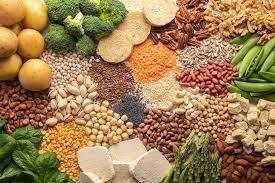Protein is an essential nutrient that plays a crucial role in building and repairing tissues in the body, and plant-based protein sources have become increasingly popular for those looking to incorporate more protein into their diets. Plant-based proteins are not only beneficial for vegans and vegetarians but also for anyone looking to diversify their protein intake.
In this comprehensive guide, we’ll explore the various plant-based protein sources, including beans, legumes, nuts, and seeds. We’ll dive into the nutritional benefits of each source and provide tips on how to incorporate them into your daily diet.
We’ll also cover the potential drawbacks of plant-based protein sources and discuss how to ensure that you’re getting enough complete protein. Plus, we’ll delve into the environmental and ethical benefits of choosing plant-based protein sources over animal-based protein sources.
Whether you’re a vegan, vegetarian, or simply looking to incorporate more plant-based protein into your diet, this guide has got you covered. By the end of this guide, you’ll have a better understanding of the benefits of plant-based protein sources and be equipped with the knowledge to make informed choices about your protein intake. So, let’s dive in and discover the power of plant-based protein.
What Is Plant-Based Protein?
Plant proteins are synthesized from protein sources that are found in plants. They are an excellent protein substitute for dairy-based protein powders such as whey and casein. Plant-based protein is protein sourced from plant-based sources such as brown rice, peas, soy, chia seeds, flaxseeds, hemp seeds, and legumes.
Plant proteins are extremely healthy, not only because they are high in protein, but also because they include fiber, vitamins, and minerals. Our fiber consumption is typically inadequate; but, by introducing certain plant proteins into your diet, such as pulses, peas, and nuts, you may easily increase your fiber intake.
Why Plant-Based Protein Is Important?
Simply said, protein is a macronutrient (a nutrient that humans require in bigger amounts) made up of amino acids that are stitched together into lengthy chains. Some of these chains may be produced spontaneously by your body – known as ‘non-essential’ chains – while others cannot. These are known as ‘essential’ amino acids because they must be obtained from diet. When you eat a protein-rich food, your body breaks it down into amino acids, which it then utilizes to make anything from new muscle to organs and hair.
Consuming plant-based protein can give you major benefits like:
- People who are allergic to lactose or other animal-based food can safely consume plant protein.
- Plant protein increases your calorie-burning rate, hence increasing your metabolism. It aids in the burning of fat and the development of lean muscle.
- They include all of the key amino acids needed for muscle protein synthesis and post-exercise muscle repair.
- They include dietary fiber, are low in carbohydrates and fat, and hence reduce hunger cravings.
- They digest smoothly and are gentle on the stomach, causing no GI distress.
Plant-Based Protein Sources:
Because most protein-rich food sources are lean meat, eggs, or fish, and seafood, most vegetarians are concerned about receiving enough protein from their diet. Here are some easy-to-find healthy protein-rich food sources for vegetarians that can help obtain adequate protein:
- Brown rice: Brown rice is a complete grain that includes the fiber bran, the nutritious germ, and the carbohydrate-rich endosperm. Brown rice has 5g of protein per cup. Brown rice is also high in magnesium and fiber, both of which aid with blood sugar regulation. Brown rice bran includes a high concentration of antioxidants, which can help neutralize damaging free radical molecules and decrease inflammation in the body. Eating brown rice instead of white rice may also help you lose weight, lower your BMI, and shrink the size of your waist and hips.
- Peas: Peas are high in protein because they contain all nine essential amino acids, making them a complete protein. A cup of these green beauties has approximately 9g of protein. They are also an excellent source of vitamins A, C, and K, as well as fiber and minerals including manganese, iron, and phosphorus.
- Grains: You might think of grains as large carbs, however, they also have a high protein content. A half-cup amount of oats, for example, contributes 5 grams of protein to your breakfast. A quarter cup (uncooked) of barley or quinoa adds 5 to 6 grams as well. Tiff, millet, amaranth, and other ancient grains can also be used to spice up your dishes.
- Seeds: Seeds have recently piqued the curiosity of people from all over the world due to their numerous advantages. Consuming 1-2 varieties of nuts and 1 spoonful of any roasted seed on a daily basis is an excellent approach to increasing your protein consumption. 1 ounce (28 g) of Flax seeds has roughly 5g of protein, 1 ounce of Hemp seeds contains around 8 g of protein, and 1 ounce of Pumpkin seeds contains approximately 7g of protein. They may be taken by blending them into a smoothie or soaking them and adding them to any beverage.
- Nuts: Nuts are considered superfoods and provide a great, protein-rich snack or supplement to meals. One cup of oil-roasted mixed nuts has roughly 27g of protein. Nuts are highly nutritious foods with complex matrices rich in unsaturated fatty acids and other bioactive substances: high-quality vegetable protein, fiber, minerals, tocopherols, phytosterols, and phenolic compounds. Nuts are one such food item that should unquestionably be included in your diet.
- Soy and Soy products: Soy and its products are among the highest protein sources in a plant-based diet. The protein content of soy varies depending on how it is prepared. Firm tofu (soybean curds) has around 10 g of protein every 12 cups. 12 cups of tempeh has roughly 15 g of protein. Tofu absorbs the taste of the dish in which it is prepared, making it a flexible complement to a meal. Tofu may be used as a meat substitute in popular sandwiches or soups. Tofu is also used as a meat replacement in various recipes, including kung pao chicken and sweet and sour chicken. These soy products are also high in calcium and iron, making them a healthy option for dairy products.
- Lentils and beans: A variety of lentils are good in terms of their protein content. Among one of the most famous Indian sources of proteins, there are various beans that contain an abundance of protein/gram like kidney beans, gram beans, chickpeas, etc., all delicious in taste and healthy in terms of nutrition.
- Potatoes: A big baked potato has 8 g of protein per serving. Other minerals found in potatoes include potassium and vitamin C. Add 2 tablespoons of hummus for a tasty snack that is lower in fat than butter-covered potatoes and higher in protein. Hummus contains roughly 3 g of protein in two tablespoons.
- Edamame: These lightly cooked or steamed soybeans, which are commonly served in their shell, are an excellent snack or appetizer. One cup of edamame (unshelled) has 18 grams of protein. What’s even better? Whole soy is a complete protein, which means it contains all of the amino acids that your body need but cannot produce on its own.
- Nutritional Yeast: Many vegans adore nutritional yeast’s cheese-like umami flavor, but there are various reasons why non-vegans should try it as well. It’s high in B vitamins, glutathione, an antioxidant, and protein. A quarter cup has 8 grams of protein. It also has no gluten, sugar, dairy, or artificial flavors, or additives. Mix it into soups and sauces, sprinkle it on popcorn or avocado toast, or combine it with soaked cashews to make a delicious homemade vegan cheese for pasta or veggies.
- Ezekiel bread: A nutrient-dense alternative to regular bread, Ezekiel bread Barley, wheat, lentils, millet, and spelled are used to make it. Ezekiel bread is a great option for bread fans looking for a more nutritional way to consume toast or sandwiches. Each piece of Ezekiel bread has 4 g of protein. To increase the protein content, toast the Ezekiel bread and spread it with peanut or almond butter.
- Vegetables high in protein: Many dark-colored, leafy greens and vegetables are high in protein. These items alone are insufficient to satisfy daily protein needs, but a few veggie snacks can help enhance protein consumption, especially when coupled with other protein-rich meals. A single medium stalk of broccoli provides roughly 4 g of protein, a cup of kale contains 2 g of protein, and 5 medium mushrooms have 3 g of protein. For a protein-rich dinner, try a salad with baby greens and quinoa sprinkled on top.
- Spirulina: This blue-green algae is a nutrient-dense superfood. A 2-tablespoon (14-grams) portion contains 8 grammes of complete protein, as well as 22 percent of your daily iron requirements and 95 percent of your daily copper requirements. Spirulina is also high in magnesium, riboflavin, manganese, potassium, and a little quantity of the majority of other minerals your body need, including vital fatty acids.
- Quinoa: Quinoa has 8–9 g of protein per cooked cup (185 grams) and is a complete protein source, which is unusual among grains and cereals. Quinoa are also good sources of complex carbs, fiber, iron, manganese, phosphorus, and magnesium.



